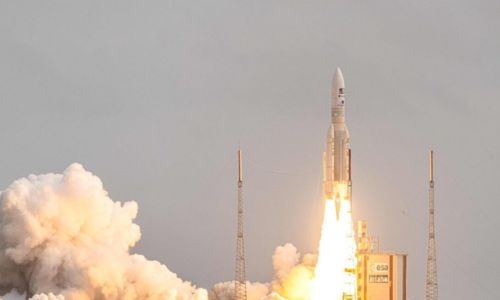Europe’s JUICE mission blasts off towards Jupiter’s icy moons
AFP |Paris
The Daily Tribune – www.newsofbahrain.com
The European Space Agency’s JUICE space probe successfully launched yesterday on a mission to discover whether Jupiter’s icy moons are capable of hosting extraterrestrial life in their vast, hidden oceans.
The launch on an Ariane 5 rocket from Europe’s spaceport in Kourou, French Guiana came after a previous attempt on Thursday was called off due to the risk of lightning.
Despite cloudy skies, the rocket took off as planned at 09:14 am local time (1214 GMT) yesterday, as guests including Belgium’s King Philippe watched from the Guiana Space Centre.
A little under half an hour later, the uncrewed six-tonne spacecraft separated from the rocket at an altitude of 1,500 kilometres (930 miles), which prompted an outbreak of applause at the centre.
Stephane Israel, the CEO of French firm Arianespace in charge of the rocket, said the launch was “a success”.
After a few tense minutes, ground control were relieved to receive the first signal from spacecraft.
The spacecraft then began unfurling its array of solar panels, which are a record 85 square metres, the size of a basket-ball court.
It will need all the energy it can get near Jupiter, where sunlight is 25 times weaker than on Earth.
Carole Larigauderie, JUICE project head at France’s space agency CNES, said the launch the beginning of a long journey which will “not be at all calm”.
The Jupiter Icy Moons Explorer (JUICE) will take a long and winding path to the gas giant, which is 628 million kilometres (390 million miles) from Earth.
It will use several gravitational boosts along the way, first by doing a fly-by of Earth and the Moon, then by slingshotting around Venus in 2025 before swinging past Earth again in 2029.
When the probe finally enters Jupiter’s orbit in July 2031, its 10 scientific instruments will analyse the Solar System’s largest planet as well as its three icy moons Europa, Ganymede and Callisto.
Related Posts

